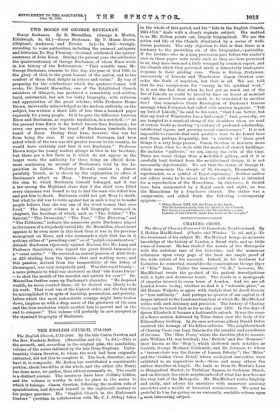THE ENGLISH CHURCH, 1714-1800.
The English Church, 1714-1800. By the late Canon Overton and the Rev. Frederic Relton. (Macmillan and Co. 7s. 6d.)—This is the seventh, and, according to the original plan, the concluding, volume of the series initiated by the late Dean Stephens. Unfor- tunately Canon Overton, to whom the work bad been originally entrusted, did not live to complete it. The book, therefore, as we have it, is composite. Mr. Kelton has contributed a considerable portion, about two-fifths of the whole, and the editor (Dr. Hunt) has done more, we gather, than editors commonly do. The result is a distinct success. The iuncturae have been skilfully hidden, and the volume is worthy to tako its place in the series to which it belongs. Canon Overton, following the modern rule of specialisation, had devoted himself to the eighteenth century as his proper province. His " English Church in the Eighteenth Century " (written in collaboration with Mr. C. J. Abbey) takes in the whole of this period, and his "Life in the English Church, 1661-1714," deals with a closely cognate subject. His method is, as Mr. Relton points out, largely biographical. We see the action and life of the Church illustrated by a series of well- drawn portraits. The only objection to this is that there is a tendency to the prevailing sin of the biographer,—partiality. If the prelates who in a long procession pass before the reader's view in these pages were really such as they are here presented to us, they have been not a little wronged by common report, and the Church which they governed made a lamentably inadequate response to their guiding care. There is Bishop Pretyman, successively of Lincoln and Winchester: Canon Overton con- cedes the fault of nepotism, but that is all. We are told that he was conspicuous for "energy in his spiritual work." Is it not tho fact that when he had got as much out of the See of Lincoln as could be raised by fines on leases at nominal rents he moved heaven and earth to be translated to another See ? One remembers Shute Barrington of Durham's famous message when Pretyman had called with anxious inquiries. " Tell my lord of Lincoln," he said to his valet, " that I am better, but that my lord of Winchester has a bad cough." And, generally, we are tempted to a sceptical shrug of the shoulders when we read of certain books as marking " a century of profound scholarship, intellectual vigour, and growing moral consciousuess." It is not impossible to concede that such qualities were to bo found here and there, perhaps frequently, but "a century of " these good things is a very large phrase. Canon Overton is nowhere more severe than when he deals with the neglect of church buildings. He includes "galleries," wo see, among the evils of the time. There are worse things than a well-filled gallery, and if it is carefully kept distinct from the architectural design, it is not necessarily objectionable. We see that the statue of George H. which surmounts the steeple of St. George's, Bloomsbury, is reprehended, as a symbol of Royal supremacy. Neither author nor editor seems to be aware that the said steeple is intended for a reproduction of the Mausoleum. In strictness, it should have been surmounted by a Royal coach and eight, as was the Mausoleum by a four-horse chariot. The statue was a compromise, and called forth the following contemporary epigram:—
When Henry VIII. left the Pope in the lurch, The Protestants made him the Head of the Church. But George's good subjects, the Bloomsbury people, Instead of the Church, made him head of the steeple."


























































 Previous page
Previous page